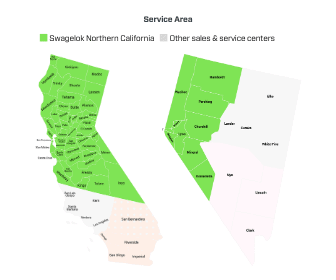Menu
Product Catalogs
Industries
About
Resources
Shop
/Digital%20montage%20(1).jpg?width=1920&name=Digital%20montage%20(1).jpg)
by Swagelok Northern California

Your fluid systems can't fail—and they can't leak. That's why Swagelok Northern California offers mission critical solutions for the petrochem, semi, power, and oil and gas industries around the Bay Area and into NW Nevada. We manufacture and assemble reliable, customizable components that get the job done. Contact our team today to learn about custom solutions for your plant or refinery.
3393 W Warren Ave
Fremont, CA 94538
Main tel: 510-933-6200
Email: Message us

*If you are not located in our service area, we route your request to your local Swagelok Sales and Service Center as soon as possible.
*If you are not located in our service area (northern California and northwestern Nevada), we will route your request to your local Swagelok Sales and Service Center as soon as possible. You can locate the contact information for your local Swagelok Sales and Service center at http://www.swagelok.com/en/locate-a-sales-service-center.
Swagelok Northern California
Swagelok Northern California is a locally owned sales and service center of Swagelok, a company celebrating 75 years in business. We have locations in Fremont, Sunnyvale, and Concord, CA (USA). Phone: 510-933-6200.